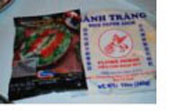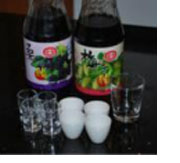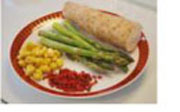
| What is Flavor and Fortune? |
| How do I subscribe? |
| How do I get past issues? |
| How do I advertise? |
| How do I contact the editor? |
Read 12880167 times
Connect me to:
| Home |
| Articles |
| Book reviews |
| Letters to the Editor |
| Newmans News and Notes |
| Recipes |
| Restaurant reviews |
| Article Index (all years, slow) |
| List of Article Years |
| Article Index (2025) |
| Article Index (last 2 years) |
| Things others say |
| Related Links |
| Log In... |
| Authors |
| Categories & Topics |
Chinese 'Slow Food' on Christmas Day
| by Lee, Hsi Ming |
Personal Perspectives
Winter Volume: 2011 Issue: 18(4) page(s): 5 and 6
Ask Jews what do they do on Christmas day and many say they go to a Chinese restaurant. Many then follow that meal with a late movie. With the first item in mind, we invited some Jewish friends to our house to share a 'Slow Food' meal. For those who do not know about this type of eating, 'Slow Food' is a way of living and a way of eating. It complies with eco-gastronomy; in other words, 'Slow Food' is healthy, clean, and fair. Our Slow Food meal began with two appetizers.
EGGPLANT POCKETS, so named by the editor who was there, were made with slices of eggplant, each almost cut in half then stuffed with ground pork. This dish is my husband''s favorite, he loves its tender yet crisp texture. Another reason he loves them, because they are filled with childhood memories, especially those of his mother; she passed away six years ago. This dish is not common at banquets, but is very popular in southern China and considered a Chuan-style dish.
To make them, ground pork is marinated with soy sauce, minced ginger, scallions and rice wine. The best eggplant for this dish are the long thin Asian kind. He cut them into thick slices on an angle, then made a cut part-way down but not all the way through every slice making the eggplant pocket. He stuffed the marinated pork into the pocket between each thick slice. These he dipped into a prepared batter and fried them for two minutes. With love and fond memories, everyone enjoyed this dish with him.
Since my younger son married a beautiful Vietnamese-American girl, we have grown fond of her cuisine and do learn more about the food of her culture. Vietnamese food emphasizes fresh vegetables and/or fresh herbs; they are essential side dishes along with dipping sauces that can include fish sauce or soy sauce and a diverse range of herbs such as lemon grass, mint, coriander and basil leaves. The sauces and the herbs add flavor to their fruits and vegetables.
VIETNAMESE SPRING ROLLS were the second appetizer with fillings of rice vermicelli, bean sprouts, carrots, hot pepper, and some arctic clams, shown below in a black plastic bag. One can use any shellfish or any meat cooked and cut into small pieces. The rice-paper wrapper, on the right side of the picture, is soaked in warm water, one at a time, for about one minute each until soft. The vegetables and sea food and/or meat are rolled into the rice-paper and seasoned with or served with a dipping sauce. Together, they provide heavenly tastes.
SPRING ROLL DIPPING SAUCE We used this evening was one part fish sauce, one part sugar, two parts water, half a part vinegar mixed with chopped garlic, and salt and pepper, to taste. Vietnamese people, proud of their food culture, have a saying: You do not have to go looking for great food in Vietnam, it will find you.
We used this evening was one part fish sauce, one part sugar, two parts water, half a part vinegar mixed with chopped garlic, and salt and pepper, to taste. Vietnamese people, proud of their food culture, have a saying: You do not have to go looking for great food in Vietnam, it will find you.
FOR LIFE and for the health of living, we shared and enjoyed a 2008 bottle of Australian Riesling from Polish Hill River. Then we went to the table for dinner. It started with three appetizers there awaiting us. One was marinated Jelly fish with celery and cucumber, another a spiced beef and dried bean curd dish, and the third appetizer which included mountain yam, gingko nuts, asparagus, and goji berries seen here were these vegetables prepared and actually called: For Life
Mountain yam in Chinese is shan yao, it is one of the most important and commonly used materials in the Chinese medicinal repertoire. Considered a neutral herb, it is able to tonify qi without injuring a person''s yin. In this dish it is cut into pieces, soaked in vinegar-water and rinsed a couple times to remove any irritant oxalate crystals and slimyness.
The yam in it can be eaten raw or stir-fried for two minutes, its taste is starchy and bland. The ginkgo nuts, bai guo, are from a tree botanically known as Ginkgo biloba. Extract of ginkgo leaves and their fruit, called ginkgo nuts, have various food and traditional medicinal uses. The goji berries, once known as wolfberries, are red and most nutritious. They have antioxidant properties. Asparagus is low in calories, low in sodium, and a good source of vitamin B6, calcium, magnesium, zinc, and dietary fiber. All these ingredients were lightly stir-fried and served without sauce to highlight their colors of white which is the mountain yam, yellow for the gingko nuts, green is the asparagus, and red is the goji berries. This clean healthy dish was art for the eyes, health for the stomach.
SCALLOP CREAM SOUP was next on the dinner menu. Making it required eight cups of water and one cup of heavy cream boiled for fifteen minutes with thin slices of ginger, one of the most used ingredients in Chinese cooking. Its medicinal uses are important in winter to prevent or treat colds and flu. Traditional medical practitioners say on a wintry morning to drink a half cup of warm ginger soup with or without honey and lemon or to chew a piece of ginger. These are considered better than Ginseng to boost energy.
Two types of mushrooms were used in this soup, the oyster and those known as golden needles. We used bay scallops and marinated them in rice wine with scallions in the refrigerator for an hour. While the soup stock came to the boil, we dropped the scallops coated with cornstarch, the mushrooms, too, and let them cook for three minutes until the scallops turned opaque. After this hot and hearty soup, no one felt cold any more even though this was a cold deep winter night.
 Plum or mulberry vinegar on ice was served as a cleanser. They came to the table in bottles with mini shot glasses, as seen in the picture. Everyone was surprised and delighted as they downed these refreshing vinegar treats. I intended asking the guests to take a walk outside to digest their food. However, because of the freezing temperature this idea was not implemented.
Plum or mulberry vinegar on ice was served as a cleanser. They came to the table in bottles with mini shot glasses, as seen in the picture. Everyone was surprised and delighted as they downed these refreshing vinegar treats. I intended asking the guests to take a walk outside to digest their food. However, because of the freezing temperature this idea was not implemented.
PAN GRILLED TIGER SHRIMP were next, cleaned and deep cut almost in half leaving their shells on. These were marinated with ginger, scallion and rice wine. No common method to soften the shrimp was needed. Popular is basting the shrimp in hot-then-warm oil, but instead they were pan-fried with lots of diced garlic. I would not say this dish is really fried, rather it is more grilled, a light sweet and sour sauce added at the end. The shrimp were served on a bed of stir-fried red and green peppers. Together they had good color, fine flavor, and terrific taste.
Beef is not always easy to cook Chinese style, so we decided to broil the flank steak five minutes on each side leaving some parts medium-rare and others medium-well done. This was perfect for various preferences that might exist. The steak was thin-sliced and served immediately and over blanched Chinese broccoli. It came out delicious and done to many different tastes.
COCONUT DIPPING SAUCE made with one cup of coconut cream mixed with Jelly-like young coconut fruit, on the side, was there for those wanting it. Accompanying the main courses were two bottles of 2007 black label Claret from the Francis Coppola collection
STEAMED ROOT VEGETABLES  were the first main course. This dish included Japanese yam, purple yam, taro root, and Japanese pumpkin, shown here. They were steamed some twenty minutes, except for the medium sized Japanese pumpkin which was steamed five minutes longer. All were cut bite-size and needed no seasoning. Each was delicious with its own flavor.
were the first main course. This dish included Japanese yam, purple yam, taro root, and Japanese pumpkin, shown here. They were steamed some twenty minutes, except for the medium sized Japanese pumpkin which was steamed five minutes longer. All were cut bite-size and needed no seasoning. Each was delicious with its own flavor.
STEAMED PATAGONIAN TOOTH FISH completed this 'Slow Food' Chinese meal. Two months ago when visiting my parents in Taiwan, noted that their freezer was full of packages of individually wrapped fish steaks. These have a delicious flavor and texture as the fish they had lots of was Chilean sea bass, also called Patagonian Toothfish. These fish like the cold temperature of the southern hemisphere. The best ones are from the Ross sea at the southern most sea before the Antarctic Ocean.
This fish is moderately oily, and as my husband commented, no matter how you cook them you can not ruin them. I brought some home, marinated two large pieces with rice wine, ginger and scallion for three hours, then put them in the microwave for six minutes. After that, I added salt to taste. The guests adored their delicious flavor, were impressed with how easy they were to make, and in Yiddish tasted us saying L'Chiam. They wished us cheers for life and health; and we toasted them back using mulberry vinegar toasting each others'' health.
Desert time, what dessert? My friends knew better so they brought an apple pie and some bourbon brownies. Nothing can compare to their fresh home-made apple pie and bourbon brownie truffles brought with them from New York City. These two sweets went well with freshly brewed hot tea, a Taiwan high mountain oolong.
Thanks to all my friends for giving me this chance to plan, design and execute this fantastic 'Slow Food' meal. This article is a belated birthday gift to our food savvy friend in celebration of his eighty-year-young birthday. Happy Birthday friend!
_____
Thanks to Yin-Nan Lee for his fine photographs.

Copyright © 1994-2025 by ISACC, all rights reserved
Address
3 Jefferson Ferry Drive
S. Setauket NY 11720